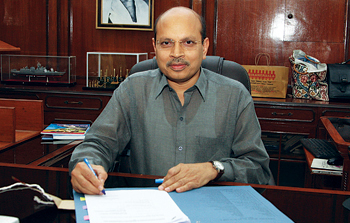INDIAN ARMED FORCES CHIEFS ON OUR RELENTLESS AND FOCUSED PUBLISHING EFFORTS

The insightful articles, inspiring narrations and analytical perspectives presented by the Editorial Team, establish an alluring connect with the reader. My compliments and best wishes to SP Guide Publications.

"Over the past 60 years, the growth of SP Guide Publications has mirrored the rising stature of Indian Navy. Its well-researched and informative magazines on Defence and Aerospace sector have served to shape an educated opinion of our military personnel, policy makers and the public alike. I wish SP's Publication team continued success, fair winds and following seas in all future endeavour!"

Since, its inception in 1964, SP Guide Publications has consistently demonstrated commitment to high-quality journalism in the aerospace and defence sectors, earning a well-deserved reputation as Asia's largest media house in this domain. I wish SP Guide Publications continued success in its pursuit of excellence.
- Appointments Committee of Cabinet approves one-month extension in service of Chief of the Army Staff
- Admiral Dinesh K. Tripathi assumes Command of the Indian Navy as 26th Chief of the Naval Staff
- Prime Minister witnesses 'Bharat Shakti' – a Tri-Services Firing and Manoeuvre Exercise in Pokhran, Rajasthan
- Interim Defence Budget 2024-25 — An Analysis
- Union Defence budget 2024
- Prime Minister Modi Commemorates Indian Navy Day in a Grand Ceremony
Resurgent Indian defence industry
In a rare media interaction with SP’s M.A.I., Ashok Kumar Gupta, Secretary, Defence Production, outlined his vision for defence manufacturing in India and addressed a wide range of subjects including ‘Make in India’, DPP 2016, defence offsets, role of DPSUs, investment in R&D, delays in procurement decisions, blacklisting and other related issues

SP’s M.A.I. (SP’s): What is your vision for India’s domestic defence industry in terms of defence production?
Secretary, Defence Production (Secretary): As India is transforming from a regional power to a global power, the defence sector is increasingly occupying a bigger space in the country’s long-term strategic planning. A confident and resurgent Indian defence industry is making forays into almost all the sectors of manufacturing. Lately, the huge opportunities for growth within the domestic and global defence and aerospace industries have attracted the attention of Indian industry.
It is pertinent to mention here that the Defence Production Policy promulgated by the government aims at achieving substantive self-reliance in the design, development and production of equipment, weapon systems, platforms required for defence in as early a time frame as possible, creating conditions conducive for private industry to play an active role in this endeavour; enhancing potential of small and medium-sized enterprises (SMEs) in indigenisation and broadening the defence R&D base of the country.
Pursuant to the above policy and ‘Make in India’ initiative, the government aims to make the country self-reliant in defence production, through various initiatives. Several policy initiatives have already been implemented by the government such as liberalisation of FDI (foreign direct investment) policy and industrial licensing policy, simplification of export procedures, creating level playing field for Indian private and public sector companies, streamlining of offset implementation process, providing preference to ‘Buy (Indian Designed, Developed and Manufactured)’ (Indian-IDDM), ‘Buy (Indian)’, ‘Buy and Make (Indian)’ categories of capital acquisition over ‘Buy (Global)’ category in Defence Procurement Procedure.
SP’s: The new DPP 2016 is being referred to as game changer for the sector. How do you see it altering the Indian defence growth story?
Secretary: The new Defence Procurement Procedure (DPP) 2016 has come into effect from April 1, 2016. It focuses on achieving the ‘Make in India’ vision by according priority to ‘Buy (Indian–IDDM)’ and ‘Buy (Indian)’ categories. It also mandates increased indigenous content. The ‘Make’ procedure has been simplified with provisions for funding of 90 per cent of development cost by the government to Indian industry and earmarking projects not exceeding development cost of Rs. 10 crore (government funded) and Rs. 3 crore (industry funded) for the micro, small and medium enterprises (MSMEs).
This would create an ecosystem in defence manufacturing by harnessing the capabilities of Indian private sector specially MSMEs and inculcate the R&D culture in the sector.
SP’s: In your opinion, what are the new key points of DPP 2016 for a foreign OEM looking at Indian market?
Secretary: India is in the midst of modernising its armed forces and it is estimated that $250 billion will be spent on capital procurement in the next 10 years. In the new Defence Procurement Procedure 2016, ‘Buy (Indian-IDDM)’, ‘Buy (Indian)’, ‘Buy & Make (Indian)’ are the most preferred categories which means that increasingly request for proposals (RFPs) will be issued to the domestic industry. The only way for the foreign original equipment manufacturers (OEMs) to leverage domestic demand is to tie up with domestic companies either for collaborative R&D followed by production or through transfer of technology for production through joint ventures or they can set up their own manufacturing base.
In addition, a numbers of potential ‘Make’ projects have been identified by the department; which are likely to follow ‘Make’ procedure for development-cum-procurement. The foreign OEMs can collaborate with the Indian vendor, the prime contractor, for development for defence equipment.
Provisions have also been introduced to allow foreign OEM to select Indian production agency of its choice for transfer of technology for maintenance infrastructure.
Moreover, offset implementation process has been made flexible by allowing change of Indian offset partners (IOPs) and offset components, even in signed contracts. Foreign OEMs are now not required to indicate the details of IOPs and products at the time of signing of contracts.
SP’s: How exactly are the ‘Make in India’ initiatives for aerospace and defence sector being promoted? What has been the reaction of foreign OEMs to it till date?
Secretary: ‘Make in India’ initiatives for aerospace and defence sector are being promoted though various policy initiatives and amendments in procurement procedures which would result in ease of doing business, encourage and facilitate Indian private sector to participate in defence manufacturing, nurturing R&D culture in defence.
Following initiatives have been taken by the Department of Defence Production to boost the ‘Make in India’ in defence sector:
- Foreign Direct Investment: FDI policy under which foreign investment is allowed through automatic route up to 49 per cent and government route beyond 49 per cent wherever it is likely to result in access to modern technology or for other reasons to be recorded.
- Industrial Licensing: The Defence Products List for the purpose of issuing industrial licences (ILs) under IDR Act has been revised and most of the components, parts, subsystems, testing equipment and production equipment have been removed from the list so as to reduce the entry barriers for the industry, particularly small and medium segment. The initial validity of the industrial licence has been increased from three years to 15 years with a provision to further extend it by three years on a case-to-case basis.
- Defence Exports:
- The list of military stores has been ?nalised and put in the public domain so as to make the process transparent and unambiguous. The process of receiving applications for no objection certi?cate (NOC) for export of military stores and for issuing NOC has been made online.
- The standard operating procedure (SOP) for the issue of NOC for export of military stores has been revised and put on the website. Under the revised SOP, the requirement of enduser certi?cate (EUC) to be countersigned/stamped by the government authorities has been done away with for the export of parts, components, subsystems, etc.
- Recognising the need for promotion of defence exports to make the Indian defence industry economically sustainable, defence exports strategy outlining the various steps to be taken has been formulated and put up in public domain.
- Defence Offsets: Offset implementation process has been made flexible by allowing change of Indian offset partners (IOPs) and offset components, even in signed contracts. Services as an avenue of offset have been reinstated with certain conditionalities.
- Level Playing Field:
- Exchange rate variation protection has been made applicable for Indian private sector at par with public sector undertakings for all categories of capital acquisitions.
- The preferential treatment given to defence public sector undertakings (DPSUs) in excise duty/customs duty has been discontinued. As per the revised policy, all Indian industries (public and private) are subject to the same kind of excise and customs duty levies.
- ‘Make’ Procedure: The ‘Make’ procedure has been revised to promote indigenous design, development and manufacture of defence equipment/platform. It provides for enhanced government funding of 90 per cent of development cost and preference to MSMEs for certain categories of projects, which will give a tremendous boost to manufacturing of indigenously designed products through collaborative process with Indian industry.
- ‘Buy (Indian-IDDM)’ in DPP 2016: One of the notable features of DPP 2016 is the introduction of a new procurement category ‘Buy (Indian-IDDM)’ by which priority has been accorded to procurement from Indian vendors of products that are indigenously designed, developed and manufactured.
- Preference to Indigenous Procurement: In DPP 2016, preference has been provided to procurement under ‘Buy (Indian-IDDM)’, ‘Buy (Indian)’ and ‘Buy and Make (Indian)’ categories of capital acquisition over ‘Buy & Make’ or ‘Buy (Global)’ categories.
The foreign OEMs have exhibited a lot of enthusiasm to participate in ‘Make in India’ initiative. Several OEMs have entered into or are in the process of tie-ups with Indian defence companies for supply of defence equipment categorised as ‘Buy and Make (Indian)’ and ‘Buy and Make’.
For the complete interview, refer to SP’s Military Yearbook 2016-2017





